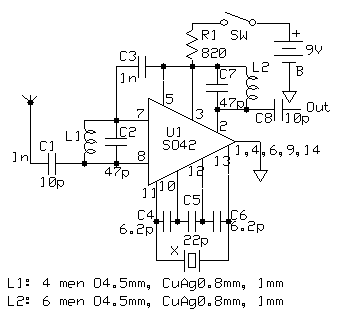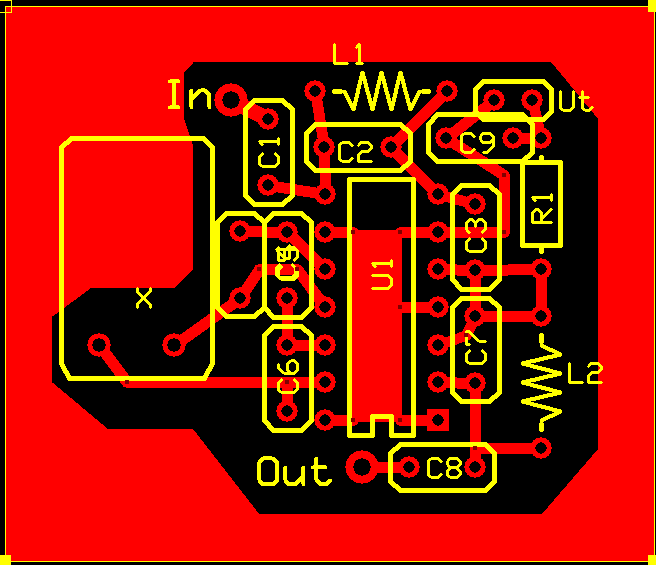CCIR-OIRT converter
for old radios
The OIRT FM broadcast band covers 65.8 MHz to 74 MHz (with 30kHz spacing), and was used in the Union of Soviet Socialist Republics and most of the
other socialist member countries of the International Radio and Television Organisation in Eastern Europe (formed by East-Germany, Baltic countries (Lithuania, Estonia, Latvia), Poland, Czech and Slovakia (before Czechoslovakia), Hungary, Romania, Bulgaria, and Slovenia/Croatia/Serbia/North-Macedonia/Bosnia-Herzegovina/Kosovo/Montenegro all as part of ex-Yugoslavia) shortly OIRT.
After 1990, a number of those countries have either added the 87.5-108 MHz band (with 100kHz spacing in Europe), noted as CCIR and are operating both FM bands simultaneously, and later all of them shut down their OIRT band.
The future of broadcasting on OIRT FM band was predicted already at mid of '90s, due to appearing of plenty of new stations which transmitted exclusively on 87.5-108 MHz band, and all postcommunist countries in Eastern Europe now primarily use the 87.5 to 108 MHz band, as in the case of Russia.
In those East European or post-Soviet countries can be found old radios in quite good conditions, with very good selectivity which can receive FM signals just on the OIRT band
To modify the FM band of a receiver exists 2 possibilities:
- complete readjustment, modification of RF circuits (changing
capacitors or varicap diodes, adjusting coils, etc - but this way is impossible to be
followed by amateurs without right instrumentation, and in most of the case
the result is lower selectivity, not covered the whole band, etc.),
- using converter, an additional circuit - untouching the original radio FM circuit, and keeping the selectivity as it was.
For that reason, I propose this converter - which is easy to be built. Changing or swithching between 2-3 quartz crystals can be received any parts/sub-bands or the full band of CCIR.
The OIRT (66-74MHz) bandwidth is 8 MHz wide, the CCIR (87.5-108 MHz) bandwidth is 20.5 MHz, which means the full CCIR band can be transposed in 3 sub-bands into OIRT (ex. 87-94 MHz, 94-101 MHz, and 101-108 MHz).
The below-presented circuit is a mixer, based on SO42 symmetrical mixer IC made by Siemens (complete identical replacements: UL1042 made by Unitra, or K174PS1 Russian version - both also pin-compatible). This IC was widely used as a mixer in short wave or FM radios in the '80-'90s.
L1C2 filter covers the full CCIR band, and L2C7 covers the full OIRT band. Changing them, we can have an OIRT-CCIR converter!
Coil parameters:
L1 - 4 turns on 4.5mm drill-bit, CuAg, or CuZ 0.8mm wire. The distance between turns is 1mm.
L2 - 6 turns on 4.5mm drill-bit, CuAg, or CuZ 0.8mm wire. The distance between turns is 1mm.

Figure 1 This is the schematic diagram of the converter.
An example of pcb pattern can be seen in Figure 2.

Figure 2 The pcb drawing - as an example - from
the components side.
The crystal selection is not easy when we would like to use just one: must be checked the most often listened 8MHz bandwidth of CCIR band, and from the band starting frequency can be subtracted the OIRT band starting frequency (66MHz). The crystal frequency will be between 21-36MHz, and you should try to find the closes one to your calculation.
I recommend being inserted the whole circuit into a metallic box, with 3 terminals: input, output, and the power supply. The box should be connected to the ground of the circuit.
As antenna can be used a simple 10-20 cm wire, and the output can be inserted into radio FM antenna input or connected to the radio's telescopic antenna.
The power supply is not critical, can be between 7.5-12V.
Advantage:
- can be used in case of any radio, the radio does not need any modification,
- connection: via telescopic antenna or FM antenna input of radio. If you have some knowledge in radio repair, you can insert it into the radio between telescopin antena and FM tuner input
- no adjustment needed, if it is rightly made, will start immediately.
Update1 (15.07.2022):
Please consider, the 3rd harmonic if quartz frequency can be on the FM band, or can match with your station's frequency what you would like to listen to. In such a case is better if you change your quartz to a lower or higher frequency value, but close to your selected one.
Update2 (15.04.2019):
Another popular IC used as a mixer for FM converters is LA1185 (FM Front-end for Radio-cassette Recorder) manufactured by Sanyo. An example of a converter made with this IC can be seen on elektrotanya webpage.
The FM broadcast band in Japan uses 76 MHZ to 95 MHz, this is almost the same wide as CCIR: 19 MHz instead of 20.5 MHz of CCIR. The difference between bottom band frequencies is 12 MHz, which means with a 12 MHz oscillator/quartz the CCIR band can be transposed on Japan FM band (excepting the top 1 MHz, the part 107-108 MHz). For this reason, the converters are very popular in all countries which use resold Japanese cars with original radios. For such Japanese car-radios can be purchased converters on ebay for 8-12$, including the shipping cost. Is very cheap to buy such a converter and just change the mixer quartz in them with the right one.
.